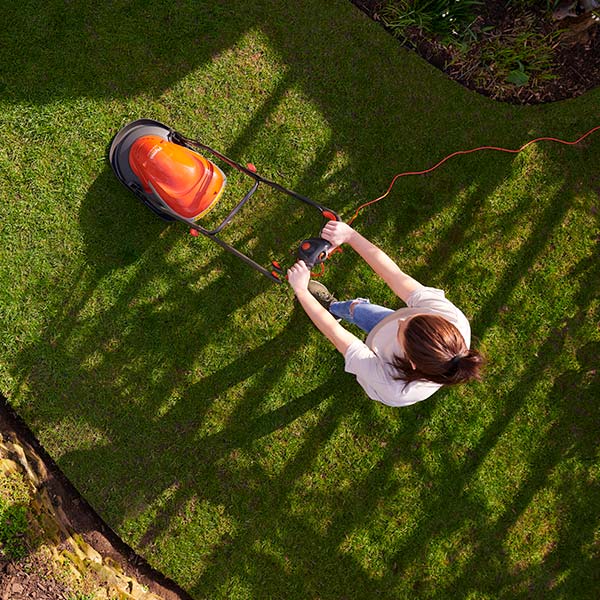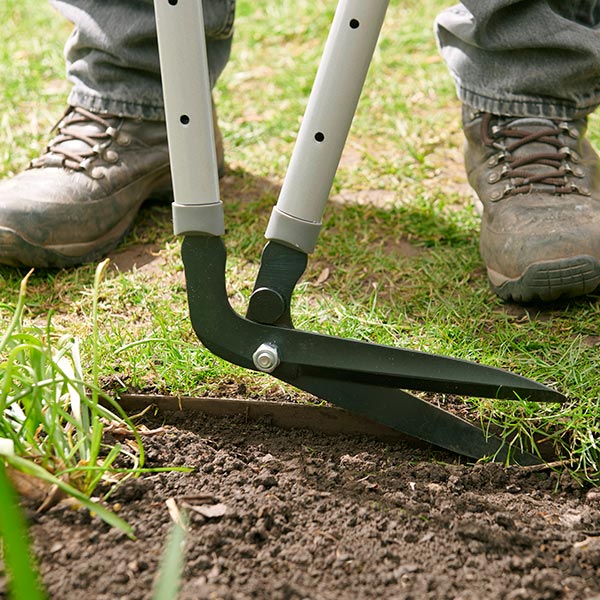4 Step guide to maintaining your lawn
By showing your lawn some love and attention, you can create a beautiful lawn that can be enjoyed the whole year through!
 By Rochelle
By Rochelle- 4th June 2021
- 5min read
Your 4 Step Guide to the Perfect Lawn
Is there anything more satisfying to a gardener than a tidy, luscious lawn? Keeping on top of the health and appearance of your grass is easy once you know how, and we've put together 4 easy steps to follow to make sure your lawn looks great all year!
Step one
Mowing
During the warmer spring and summer months, mowing is a very important job. Helping to keep your lawn in good health, you should mow your lawn as frequently as it requires. In spring, you'll find it needs to be mowed slightly less than summer, which is when it enters into overdrive! Your lawn goes dormant over winter, so you can pop the lawn mower away over that time.
Even though giving your grass a close shave might look good (and keep the grass looking better for longer), it can damage your grass, making it more susceptible to damage and drought. Keep your grass height around 40mm (1.5in) in spring and around 13-25mm (1/2-1in) in summer.
If your lawn often has a hard time (playing host to regular football matches, for example), then you might want to keep it slightly longer so it can withstand the extra wear and tear.
Ultimately, forgetting to mow your lawn isn't the end of the world. If anything, it's better for wildlife as there'll be native flowering plants like clover which is loved by bees, and there'll be plenty of hidey-holes for other beneficial bugs in your garden.
If you've gone on holiday and the grass has grown a lot, you may want to go over it with a grass trimmer first before using the lawn mower, which will avoid damage. Cut it on its highest setting first, then gradually work your way down over the next few weeks.

Step two
Feeding
A good feed with lawn fertiliser not only makes the grass greener, but makes it grow thicker and increases its strength. This means it’s better equipped to compete with weeds, moss and weather-related stresses. If you’re planning to feed in spring, it’s best to apply a granule lawn fertiliser which will feed your lawn slowly as new growth begins. In the summer, you can then switch to a liquid feed for a faster input of nutrients and a much-needed boost to your lawn.

Step three
Weeding and treating
Weeds in your lawn isn't too much to worry about. They can make your lawn look greener for longer, and are often good for wildlife. Moss can be a bit of a pain, though! But fear not, because there are some quick and easy solutions to this that will leave your grass healthy and better able to deal with moss and weeds.
Weeding your grass - if you do want to weed your lawn, there are some non-chemical methods you should try first, such as digging them out, and scarifying or aerating your lawn. However, if a lot of weeds have established themselves in your lawn, you might want to try a chemical weed killer. Chemical weed killers should be applied when weeds are actively growing. You can use a spray lawn weed killer, which you'll need to spray on individual weeds. Or you can try a lawn feed with weed and mosskiller which is applied to the whole lawn and offers a triple effect.
Getting rid of moss - for poorly drained, damp lawns, moss can be an ongoing problem. However, spring is the perfect time to try and rectify this. Simply rake over your lawn using a stainless steel lawn rake or purpose-made scarifier.
Then, aerate your lawn with a garden fork or make your life easy with an aerator to improve drainage.
For chemical solutions, opt for a lawn sand, which feeds your lawn and kills moss with iron.
To prevent further moss growth, it's a good idea to feed your lawn on a regular basis, while maintaining it frequently. Avoid mowing it too short, and use grass seeds that are designed for shady areas (if your garden's in the shade).

Step four
Over-seeding
After the harshness of winter, or after removing weeds and moss, many lawns will have bare areas. These don’t just look unsightly, but are perfect places for weeds and moss to take over. In this case, over-seeding might be required.
Choose a grass seed which will best suit your garden needs. For example, if you have large trees or buildings causing shade then a shady lawn seed will have the best chance of thriving.
All lawn seeds will give an over-seed dosage recommendation on the packaging, so check this first. Ensure you water the seed regularly until it’s established. For an extra boost, a light layer of multi-purpose compost will help retain moisture around the seeds until they’ve rooted.

Top tips for keeping your lawn healthy
Trim the edges - Trim the edges of your lawn each time you mow it. Use an edging tool to achieve a pristine finish that will give your lawn a professional look.
Rake - Remove dead grass, debris and thatch that will prevent your lawn from thriving.
Water - If your lawn desperately needs it, give it a good water, making sure you really get to the roots. If you only water the top, this may encourage surface roots, which can cause further problems down the line. To make sure you're getting to the roots, use a fork to aerate the lawn before you begin. And don't forget to check for water restrictions in your area before you begin.
Browse our full garden range online at wilko.com
Are you proud of your lawn? We'd love to see it! Get in touch with us on Facebook, Instagram, TikTok & X.